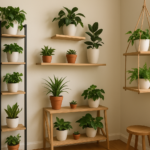Cacti are intriguing plants that captivate us with their unique forms and incredible resilience. Many people wonder How long cactus live? These fascinating plants can survive for decades, some even centuries, thanks to their remarkable adaptations. From the towering Saguaro to the compact Barrel cactus, various factors such as climate, soil, and care influence each species’s lifespan. Understanding these factors ensures your cacti thrive and live to their full potential.
In this article, we’ll delve into the secrets of cactus longevity, exploring different species’ lifespans and providing tips on caring for these resilient plants to help them live as long as possible.
Join us as we uncover how long cacti can truly live.
What Defines a Cactus?

Cacti are a group of plants belonging to the family Cactaceae. Known for their thick, fleshy stems that store water, cacti are predominantly found in arid regions. Their distinctive features include spines or scales instead of leaves, which help minimize water loss and protect them from herbivores.
Common Types of Cacti
There are hundreds of cactus species, but some of the most common include:
- Saguaro Cactus (Carnegiea gigantea)
- Barrel Cactus (Ferocactus)
- Prickly Pear Cactus (Opuntia)
- Christmas Cactus (Schlumbergera)
To know more about cacti: How to Replant a Cactus?A Step-by-Step Guide
Is Cactus a long living Plant?
Yes, cacti are generally long-living plants. Many species of cacti have adapted to survive in harsh desert environments where resources are scarce, and conditions can be extreme. These adaptations, such as water-storing stems, thick skins, and spines for protection, enable cacti to withstand drought, high temperatures, and poor soil conditions.
Some species of cacti, such as the Saguaro (Carnegiea gigantea) and the Barrel cactus (Ferocactus), can live for several decades to even centuries under the right conditions. Cacti’s longevity is often attributed to their slow growth rates, efficient water storage mechanisms, and resilience to environmental stressors.
While individual lifespans vary depending on species, habitat, and care, cacti are considered long-lived plants. Proper care and suitable growing conditions can bring beauty and interest to landscapes and indoor environments for many years.
What Makes Cactus Unique?

Cacti stand out in the plant world due to their unique adaptations and striking appearances. These remarkable plants are primarily known for their ability to thrive in harsh, arid environments. Unlike most plants, cacti have thick, fleshy stems that store water, allowing them to survive prolonged periods of drought. This adaptation is crucial for their survival in desert climates where water is scarce.
Another distinctive feature of cacti is their spines. Unlike leaves, these spines reduce water loss and protect from herbivores. Additionally, many cacti have ribbed or pleated surfaces that can expand to store more water during rainy periods and contract during droughts.
Cacti also exhibit unique flowering patterns. Their flowers are often large and vibrant and bloom infrequently, sometimes opening only at night to attract specific pollinators like bats and moths. This combination of structural adaptations and unique reproductive strategies makes cacti fascinating and resilient plants capable of enduring some of the most extreme conditions on Earth.
But Why Do Cacti Live So Long?
Cacti live exceptionally long lives due to remarkable adaptations and efficient survival strategies. One key reason is their ability to store water in their thick, fleshy stems, allowing them to endure prolonged periods of drought. This water storage capacity is crucial for surviving in the arid environments where they are typically found.
Their slow growth rate is another factor contributing to their longevity. Cacti grow slowly, conserving energy and resources, which helps them survive for extended periods. This slow metabolism reduces the wear and tear on their cells, enabling them to live longer than faster-growing plants.
Spines are another unique feature that helps cacti live longer. Unlike leaves, spines minimize water loss and offer protection from herbivores. This defensive mechanism reduces the likelihood of being eaten or damaged, allowing cacti to thrive for many years.
Cacti also have specialized root systems that can quickly absorb water from infrequent rainfalls and tolerate poor soil conditions. Their resilience in extreme temperatures and harsh climates further enhances their survival prospects.
The Oldest Living Cactus

Cacti are renowned for their longevity, with some species living for centuries. Among the oldest living cacti are some genuinely remarkable specimens that have witnessed generations come and go.
The Old Man of the Andes (Oreocereus celsius)
This Cactus, native to the high altitudes of the Andes mountains, can live for over 100 years. Known for its shaggy white hair, which protects against the sun and cold, the Old Man of the Andes is a testament to the durability and resilience of cacti in extreme conditions.
Saguaro Cactus (Carnegiea gigantea)
The Saguaro cactus holds the record for some of the oldest living cacti. Some Saguaros are estimated to be over 200 years old in Arizona’s Sonoran Desert. These giants can grow up to 60 feet tall, and their iconic arms typically begin to appear when they are around 75-100 years old. The oldest Saguaro, known as “Old Granddaddy,” lived for more than 300 years before dying in the 1990s.
Cardon Cactus (Pachycereus pringlei)
Native to Mexico’s Baja California and Sonora, the Cardon cactus is another long-lived species. Similar in appearance to the Saguaro but often more prominent, some Cardon cacti are believed to live for up to 300 years. These massive cacti can reach heights of over 60 feet and are known for their impressive longevity.
San Pedro Cactus (Echinopsis pachanoi)
The San Pedro cactus, native to the Andes Mountains in South America, is a fast-growing species but can also live for a long time, often exceeding 100 years. It has been used in traditional medicine and religious ceremonies for thousands of years, adding to its cultural and historical significance.
Average Lifespan of Common Cactus
Cacti’s lifespan is influenced by several factors, including environmental conditions, care practices, and species-specific traits. Proper watering, sunlight, soil conditions, and protection from pests are crucial for maximizing their lifespan. By understanding and catering to the specific needs of each cactus type, you can help ensure they live long and healthy lives.
Cacti are known for their impressive longevity, but their lifespan can vary significantly among different species. Here’s a look at the average lifespans of some common cacti:
Saguaro Cactus (Carnegiea gigantea)
The Saguaro cactus, a symbol of the American Southwest, is one of the longest-living cacti. These giants can live for 150-200 years, with some exceptional specimens reaching over 200 years. Their slow growth and massive size contribute to their long lifespan.
Barrel Cactus (Ferocactus)
Barrel cacti are another long-living species, typically surviving for 50-100 years. They are known for their ribbed, cylindrical shape and are well-adapted to harsh desert conditions. Their robust structure helps them withstand the test of time.
Prickly Pear Cactus (Opuntia)
Prickly pear cacti have a more modest lifespan, generally living for 20-30 years. These adaptable cacti can grow in various environments, from deserts to grasslands, contributing to their widespread presence.
Christmas Cactus (Schlumbergera)
The Christmas cactus, a popular houseplant, usually lives for 20-30 years with proper care. Unlike desert cacti, it thrives in more humid conditions and requires regular watering, especially during its blooming season.
Golden Barrel Cactus (Echinocactus grusonii)
Golden barrel cacti are known for their stunning appearance and longevity, often lasting 30-50 years. These cacti prefer full sun and well-drained soil, which is essential for their health and extended lifespan.
How Long Do Cactus Live Indoors?

Cacti are popular indoor plants because of their unique appearance and low maintenance requirements. When properly cared for, indoor cacti can live for many years, ranging from a few decades to even longer. Here are some factors that influence the lifespan of cacti when grown indoors:
Species-Specific Lifespan
The lifespan of an indoor cactus can vary greatly depending on its species. For instance:
- Christmas Cactus (Schlumbergera): Typically lives for 20-30 years with proper care.
- Golden Barrel Cactus (Echinocactus grusonii): Can live for 30-50 years.
- Prickly Pear Cactus (Opuntia): Usually has a lifespan of 20-30 years.
Proper Care
Indoor cacti can live long lives if given the right conditions:
- Light: Cacti need plenty of bright, indirect sunlight. Place them near a south-facing window to ensure they get enough light, which is crucial for their health and longevity.
- Water: Overwatering is a common mistake that can shorten a cactus’s life. Water your cactus only when the soil is arid, usually every 2-4 weeks, depending on the species and indoor climate.
- Soil: Use a well-draining cactus-specific soil mix. Good drainage prevents root rot, essential for a cactus’s longevity.
- Temperature: Cacti prefer a stable temperature. Avoid placing them near drafts, heaters, or air conditioners that can cause sudden temperature changes.
- Humidity: Most cacti thrive in low humidity. Avoid placing them in bathrooms or other high-humidity areas of your home.
Pest and Disease Management
Regularly inspect your cacti for pests like spider mites, mealybugs, and scale insects. Treat any infestations promptly to prevent damage. Also, be vigilant about signs of disease, such as discolouration or soft spots, which can indicate rot or fungal infections.
Signs That a Cactus Is Dying
Cacti are hardy plants but can still face issues leading to their decline. Recognizing the signs that a cactus is dying can help you take corrective action to save your plant. Here are some common indicators:
Discolouration
Healthy cacti are typically a vibrant green. It could be a sign of distress if you notice your Cactus turning yellow, brown, or black. Yellowing often indicates overwatering, while brown or black spots can signify rot or fungal infections.
Soft or Mushy Stems
A cactus should feel firm to the touch. Soft, mushy stems indicate root rot, often caused by overwatering or poor drainage. If the rot is severe, the affected parts might need to be removed to save the plant.
Shriveling or Wilting
While some cacti naturally shrivel slightly during drought periods, excessive shrivelling or wilting suggests a lack of water or root damage. Ensure the soil is thoroughly dry before watering and check for root health.
Foul Odor
A foul smell coming from your Cactus is a clear sign of rot. This is typically caused by bacterial or fungal infections, often due to overwatering or poor soil conditions.
Stunted Growth
If your Cactus isn’t growing as it should, it might be due to insufficient light, poor soil quality, or root problems. Healthy cacti, even those that grow slowly, should show signs of new growth during their growing season.
Root Problems
If you suspect root issues, carefully remove the Cactus from its pot and inspect the roots. Healthy roots are white or light tan. Brown, black, or slimy roots indicate rot.
Pest Infestation
Look for signs of pests like spider mites, mealybugs, or scale insects. These pests can damage the Cactus, weakening its health potentially causing death. Sticky residue, webbing, or visible bugs are signs of an infestation.
Spines Falling Off
If the Cactus starts losing its spines, it could be a sign of stress or disease. This might be due to physical damage, pests, or extreme environmental changes.
How to Revive a Dying Cactus
If you notice any of these signs, take immediate action:
- Adjust Watering: Ensure you’re not overwatering. Let the soil dry out completely before watering again.
- Improve Drainage: Use a cactus-specific soil mix and ensure the pot has drainage holes.
- Provide Adequate Light: Ensure your cactus gets enough sunlight, ideally 6-8 hours of direct sunlight per day.
- Treat Pests: Use appropriate insecticides or natural remedies to eliminate pests.
- Remove Rot: Cut away any rotting parts of the Cactus and allow the cuts to be callous before replanting.
Frequently Asked Questions (FAQs)
How can I tell if my Cactus is healthy?
Healthy cacti typically have vibrant green stems and a firm, plump appearance. Signs of good health include upright growth, new growth, and regular flowering (if applicable). Avoiding signs of discolouration, softness, or wilting indicates a healthy cactus.
Do cacti need fertilizer?
Cacti have low nutrient requirements and can thrive in nutrient-poor soils. However, providing a diluted, balanced fertilizer during the growing season can promote growth and flowering. Use a fertilizer specifically formulated for cacti and succulents, and apply it sparingly according to package instructions.
How often should I water my Cactus?
The watering frequency depends on factors such as the cactus species, the climate, and the growing conditions. Generally, it’s best to thoroughly water cacti when the soil is arid, typically every 2-4 weeks. Allow the soil to dry out between waterings to prevent root rot.
Can indoor cacti live as long as outdoor cacti?
With proper care, indoor cacti can live long and healthy lives, similar to outdoor cacti. Providing adequate light, well-draining soil, and appropriate watering are essential for indoor cacti’s longevity. While indoor conditions may differ from outdoor environments, attentive care can help indoor cacti thrive for many years.
What are signs that a cactus is dying?
Signs of a dying cactus include discolouration, soft or mushy stems, shrivelling or wilting, foul odour, stunted growth, root problems, pest infestations, and spines falling off. Identifying and addressing these signs promptly can help revive a struggling cactus and prolong its lifespan.
Conclusion
In conclusion, cacti are remarkable plants renowned for their resilience, longevity, and unique adaptations. Whether grown indoors or outdoors, cacti can thrive for many years with proper care and attention to their specific needs. By understanding the signs of a healthy cactus, identifying potential issues, and taking proactive steps to address them, you can enjoy the beauty and diversity of cacti in your home or garden for generations to come. Embrace the wonder of these desert-dwelling plants and cultivate a lasting relationship with these enduring symbols of strength and survival.







